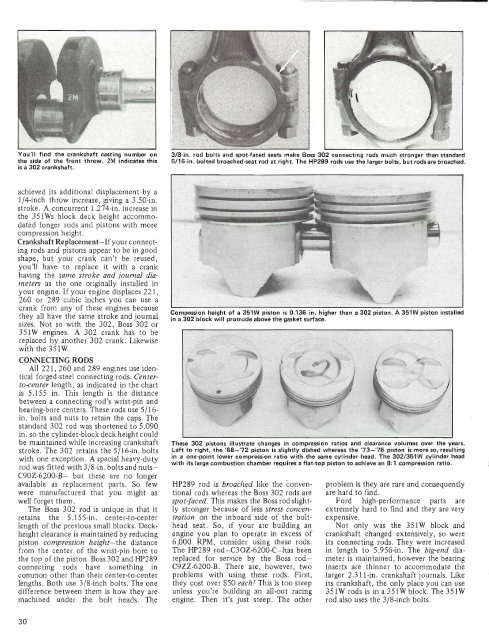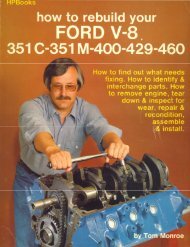How To Rebuild Your Small-Block Ford.pdf - Index of
How To Rebuild Your Small-Block Ford.pdf - Index of
How To Rebuild Your Small-Block Ford.pdf - Index of
Create successful ePaper yourself
Turn your PDF publications into a flip-book with our unique Google optimized e-Paper software.
You'll find the crankshaft casting number on<br />
the side <strong>of</strong> the front throw. 2M indicates this<br />
is a 302 crankshaft.<br />
318-in. rod bolts and spot-faced seats make Boss 302 connecting rods much stronger than standard<br />
5116-in. bolted broached-seat rod at right. The HP289 rods use the larger bolts, but rodsare broached.<br />
achieved its additional displacement by a<br />
114-inch throw increase, giving a 3 .SO-in.<br />
stroke. A concurrent 1.274-in. increase in<br />
the 351Ws block deck height accommodated<br />
longer rods and pistons with more<br />
compression height.<br />
Crankshaft Replacement-If your connecting<br />
rods and pistons appear to be in good<br />
shape, but your crank can't be reused,<br />
you'll have to replace it with a crank<br />
having the same stroke and journal diameters<br />
as the one originally installed in<br />
your engine. If your engine displaces 221,<br />
260 or 289 cubic inches you can use a<br />
crank from any <strong>of</strong> these engines because<br />
Compession height <strong>of</strong> a 351W piston is 0.136 in. higher than a 302 piston. A 351W piston installed<br />
they have the same stroke and journal in a 302 block will protrude above the gasket surface.<br />
sizes. Not so with the 302. Boss 302 or<br />
351W engines. A 302 crank has to be<br />
replaced by another 302 crank. Likewise<br />
with the 351W.<br />
CONNECTING RODS<br />
All 221,260 and 289 engines use identical<br />
forged-steel connecting rods. Centerto-center<br />
length, as indicated in the chart<br />
is 5.1 55 in. This length is the distance<br />
between a connecting rod's wrist-pin and<br />
bearing-bore centers. These rods use 511 6-<br />
in. bolts and nuts to retain the caps. The<br />
standard 302 rod was shortened to 5.090<br />
in. so the cylinder-block deck height could<br />
be maintained while increasing crankshaft<br />
stroke. The 302 retains the 5116-in. bolts<br />
with one exception. A special heavy-duty<br />
rod was fitted with 318-in. bolts and nuts-<br />
C90Z-6200-B- but these are no longer<br />
available as replacement parts. So few<br />
were manufactured that you might as<br />
well forget them.<br />
The Boss 302 rod is unique in that it<br />
retains the 5.155-in. center-to-center<br />
length <strong>of</strong> the previous small blocks. Deckheight<br />
clearance is maintained by reducing<br />
piston compression height-the distance<br />
from the center <strong>of</strong> the wrist-pin bore to<br />
the top <strong>of</strong> the piston. Boss 302 and HP289<br />
connecting rods have something in<br />
common other than their center-to-center<br />
lengths. Both use 318-inch bolts. The one<br />
difference between them is how they are<br />
machined under the bolt heads. The<br />
These 302 pistons illustrate changes in compression ratios and clearance volumes over the years.<br />
Left to right, the '68-'72 piston is slightly dished whereas the '73-'76 piston is more so, resulting<br />
in a one-point lower compression ratio with the same cylinder head. The 3021351W cylinder head<br />
with its large combustion chamber requires a flat-top piston to achieve an 8:1 compression ratio.<br />
HP289 rod is broached like the conventional<br />
rods whereas the Boss 302 rods are<br />
spot-faced. This makes the Boss rod slightly<br />
stronger because <strong>of</strong> less stress concentration<br />
on the inboard side <strong>of</strong> the bolthead<br />
seat. So, if your are building an<br />
engine you plan to operate in excess <strong>of</strong><br />
6,000 RPM, consider using these rods.<br />
The HP289 rod-C30Z-6200-C-has been<br />
replaced for service by the Boss rod-<br />
C9ZZ-6200-B. There are, however, two<br />
problems with using these rods. First,<br />
they cost over $50 each! This is too steep<br />
unless you're building an all-out racing<br />
engine. Then it's just steep. The other<br />
problem is they are rare and consequently<br />
are hard to find.<br />
<strong>Ford</strong> hgh-performance parts are<br />
extremely hard to find and they are very<br />
expensive.<br />
Not only was the 351W block and<br />
crankshaft changed extensively, so were<br />
its connecting rods. They were increased<br />
in length to 5.956-in. The big-end diameter<br />
is maintained, however the bearing<br />
inserts are thinner to accommodate the<br />
larger 2.3 1 1-in. crankshaft journals. Like<br />
its crankshaft, the only place you can use<br />
351W rods is in a 351W block. The 351W<br />
rod also uses the 318-inch bolts.
















